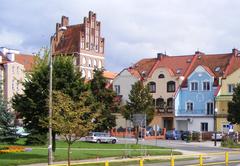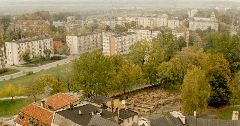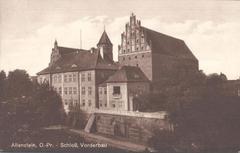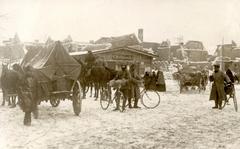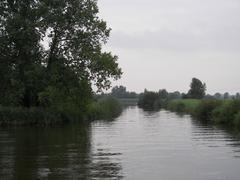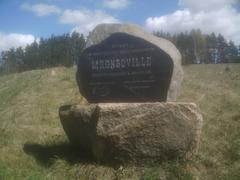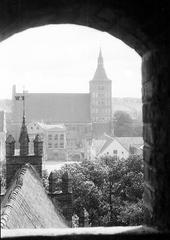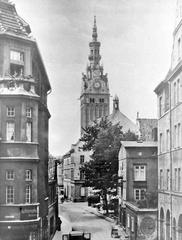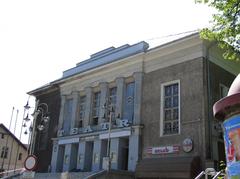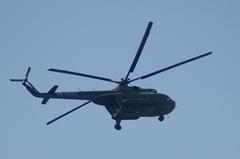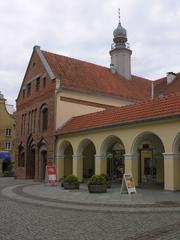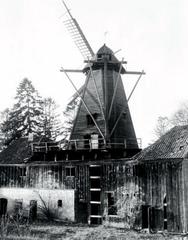Próchnik Visiting Hours, Tickets, and Historical Sites in Warmian-Masurian Voivodeship, Poland
Date: 04/07/2025
Introduction
Próchnik, a serene village in the Warmian-Masurian Voivodeship of northeastern Poland, is a hidden gem where layers of history, diverse cultural traditions, and stunning natural scenery converge. Situated within the famed Masurian Lake District—the “Land of a Thousand Lakes”—this region invites visitors to immerse themselves in a landscape shaped by centuries of human settlement and shaped by some of Poland’s most pivotal historical events. From ancient Baltic tribes and Teutonic knights to postwar transformations, Próchnik and its surroundings offer a compelling blend of heritage, architecture, nature, and rural charm (Warmians - Wikipedia, ArchaeologyMag).
This comprehensive guide explores Próchnik’s historical significance, architectural and cultural highlights, natural attractions, and practical visitor information. Whether you’re passionate about history, drawn to outdoor adventures, or seeking an authentic taste of regional traditions, Próchnik serves as an excellent base for discovering the best of the Warmian-Masurian Voivodeship.
Table of Contents
- Historical Overview: From Old Prussians to Modern Poland
- Practical Information for Visiting Próchnik
- Cultural and Natural Highlights
- Exploring Próchnik Wooden Church
- Travel Tips and Frequently Asked Questions
- Summary and Recommendations
- References
Historical Overview: From Old Prussians to Modern Poland
Early Origins and Prussian Heritage
The area surrounding Próchnik traces its roots to the Baltic Old Prussian tribes, notably the Warmians, who left a lasting imprint through archaeological discoveries and local names (Warmians - Wikipedia). These tribes thrived on agriculture, trade, and craftsmanship, establishing fortified settlements and pagan traditions that endured until the 13th century. Finds such as silver coins and medieval weaponry underscore the region’s role as a crossroads of early European trade and conflict (ArchaeologyMag).
Teutonic Conquest and Medieval Transformation
The Teutonic Knights’ arrival in the 13th century marked a turning point, as they conquered and Christianized the region, founding theocratic states and initiating waves of German and Polish settlement (Warmian–Masurian Voivodeship - Wikipedia). Medieval castles, Gothic churches, and new urban layouts from this period still define the Warmian-Masurian landscape (Travel Poland).
Polish-Lithuanian Era and Shifting Borders
The defeat of the Teutonic Order at the Battle of Grunwald in 1410 and subsequent treaties brought the region under Polish suzerainty (Warmian–Masurian Voivodeship - Wikipedia). The area flourished with new religious, educational, and commercial institutions, and a blend of Polish, German, and Baltic cultures emerged.
Prussian and German Rule
The partitions of Poland in the late 18th century annexed the area into the Kingdom of Prussia and later Germany, introducing administrative reforms, industrialization, and further demographic shifts (Warmian–Masurian Voivodeship - Wikipedia). Despite changes, traditions from multiple cultures persisted.
Twentieth Century and Postwar Realignment
Both World Wars brought upheaval, border changes, and population transfers. After World War II, the region was restored to Poland, with significant resettlement and cultural revival efforts. Today, the area’s layered past is visible in its monuments, festivals, and vibrant local communities (Talk Polish).
Practical Information for Visiting Próchnik
Visiting Hours and Tickets
- Village access: Próchnik itself is open year-round; no entry fees.
- Nearby landmarks: Museums and castles (e.g., Ostróda, Kętrzyn) usually operate 9:00 AM–5:00 PM, Tuesday to Sunday. Ticket prices: 10–25 PLN, with discounts for children, students, and seniors. Check official websites before visiting for seasonal changes.
How to Get There
- By car: Próchnik is about 20–30 km from Olsztyn, the regional capital, and is well-connected by road.
- By public transport: Regional buses from Olsztyn and Kętrzyn serve the village, though schedules may be limited in rural areas.
- By train/plane: Olsztyn is accessible by train from Warsaw or Gdańsk. The Olsztyn-Mazury Airport offers flights from several European cities.
Accessibility
Many historical sites have ramps and guided tours for people with mobility challenges, but some rural locations and older buildings (like the wooden church) may have limited accessibility. Contact local tourism offices for details.
Nearby Attractions
- Castles: Kętrzyn, Ostróda, Lidzbark Warmiński.
- Nature: Masurian Lake District, Mamry Lake, Pisz Forest.
- Unique sites: Rapa mausoleum, Boyen Fortress, Stańczyki bridges.
Guided Tours & Special Events
Seasonal guided tours focus on the Teutonic legacy, Old Prussian heritage, and local folklore. Major events include the Battle of Grunwald reenactment and the Masurian Song and Dance Festival, offering immersive cultural experiences (Polska Kultura).
Cultural and Natural Highlights
Architectural Landmarks
- Próchnik Wooden Church: An 18th-century wooden church exemplifies traditional rural architecture and religious artistry.
- Medieval Castles & Gothic Churches: Regional castles and churches display Romanesque and Gothic styles, reflecting the area’s multicultural history (polskabee.com).
Festivals and Traditions
Events such as the Masurian Song and Dance Festival allow visitors to enjoy folk music, crafts, and cuisine. Local traditions are rooted in centuries of blending Polish, German, and Baltic influences.
Outdoor Activities
- Boating & Kayaking: The interconnected Masurian lakes, including Śniardwy and Mamry, are ideal for sailing, kayaking, and motorboating (PolskaBee).
- Swimming & Water Sports: Designated beaches, windsurfing on larger lakes, and summer swimming spots abound.
- Hiking & Cycling: Marked trails in the Pisz Forest and along the Green Velo route offer varied terrain for all skill levels (Wikiloc).
- Birdwatching & Nature Walks: The region is home to white-tailed eagles, cranes, and other rare birds.
Exploring Próchnik Wooden Church
Overview
The 18th-century Próchnik Wooden Church stands as a testament to the region’s religious and architectural heritage. Its preserved wooden structure, intricate altar, and painted interiors provide insight into rural craftsmanship and local traditions.
Visiting Hours & Admission
- Open April–October, 9:00 AM–5:00 PM (verify locally for exact times)
- Admission is free; donations for preservation are appreciated.
- Guided tours can be arranged via local guesthouses or the regional tourism office.
How to Get There
- About 20–30 km from Olsztyn, accessible by car or bus.
- Nearest airport: Olsztyn-Mazury Airport.
- Contact Olsztyn Tourist Office for up-to-date transport information.
Accessibility & Photography
- Some limitations for wheelchair users due to historic structure.
- Photographs allowed; please respect the sacred space and avoid flash.
Nearby Attractions
- Masurian lakes, hiking trails, local festivals, and the historic city of Olsztyn.
Travel Tips and Frequently Asked Questions
Tips for Visitors
- Participate in Festivals: Time your visit with local events for a deeper cultural experience.
- Respect Local Customs: Use basic Polish greetings and observe rural etiquette.
- Explore Responsibly: Stay on marked trails and respect conservation rules.
- Sample Local Cuisine: Try regional dishes at village inns and during festivals.
FAQs
Q: Are there ticket fees for Próchnik or its church?
A: The village and church are free to visit; nearby museums and castles may charge 10–25 PLN.
Q: How do I get to Próchnik?
A: By car or regional bus from Olsztyn/Kętrzyn. The nearest airport is Olsztyn-Mazury.
Q: Are guided tours available?
A: Yes, in the region, including castles, nature reserves, and the church.
Q: Is the region family-friendly?
A: Yes, with safe swimming spots, easy trails, and educational activities.
Q: When is the best time to visit?
A: May–September for outdoor activities and festivals; April–October for church visits.
Summary and Recommendations
Próchnik embodies the harmonious convergence of history, culture, and nature. Visitors can explore the 18th-century wooden church, nearby medieval castles, and vibrant cultural festivals, while the Masurian Lake District presents endless opportunities for boating, hiking, and wildlife observation (PolskaBee, Kids in the City). Practical amenities, accessibility options, and guided tours make this a welcoming destination for all traveler types. For an enhanced experience, download the Audiala app for real-time updates and curated regional insights.
References
- Warmians - Wikipedia
- ArchaeologyMag: Medieval Sword and Axes Unearthed in Poland
- Warmian–Masurian Voivodeship - Wikipedia
- Travel Poland: Warmian-Masurian Region
- Polska Kultura: Warmian-Masurian Voivodeship - A Journey Through Nature, History, and Tradition
- Talk Polish: Provinces of Poland - Voivodeships Guide 2025
- polskabee.com: Masurian Lakes, Castles, Churches
- Culture.pl: All Over the Map - A Quick Tour of Poland’s Voivodeships
- Kids in the City: Mazury Lakes Region in Poland
- PolskaBee: Masurian Lakes Adventure Guide
- Wikiloc: Hiking Trails in Warmian-Masurian Voivodeship
- Poland Travel: Warmian-Masurian Voivodeship
- Warmian-Masurian Tourism Official Website
Download the Audiala app for self-guided tours, updated opening hours, activity suggestions, and travel inspiration. Follow us on social media for the latest cultural news and insider tips for your journey to Próchnik and the Warmian-Masurian Voivodeship.
